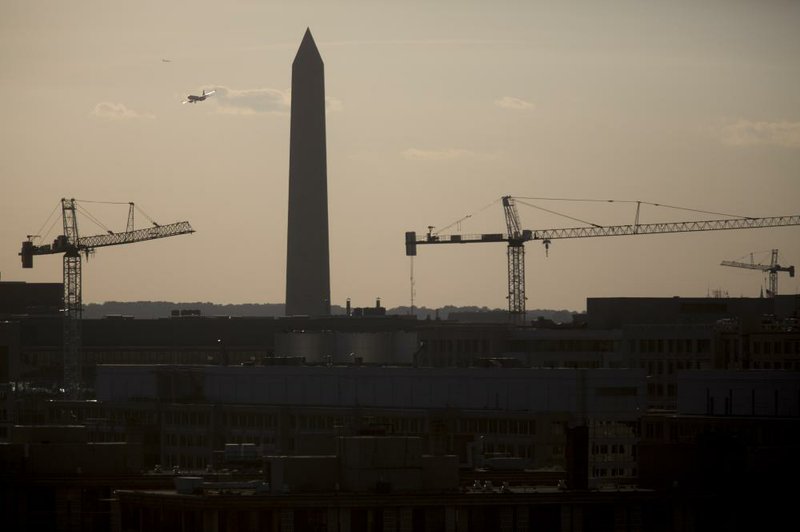WASHINGTON -- The government wants to reduce the allowable height of buildings near hundreds of airports -- a proposal that is drawing objections from real estate developers and members of Congress who say it will reduce property values.
The Federal Aviation Administration proposal, supported by airports and airlines, is driven by encroaching development that limits safe flight paths for planes that might lose power in an engine during takeoff. Planes can fly with only one engine, but they have less power to climb quickly over obstacles.
Airlines have to plan for the possibility that a plane could lose the use of an engine during takeoff even though that doesn't happen very often. As more buildings, cellphone towers, wind turbines and other tall structures go up near airports, there are fewer safe flight paths available. Current regulations effectively limit building heights based on the amount of clearance needed by planes with two operating engines.
Airlines already must sometimes cut down on the number of passengers and the amount of cargo carried by planes taking off from airports in Burbank and San Jose in California, and in Honolulu, Los Angeles, Miami, Phoenix and near Washington, D.C., among others, so they will be light enough to clear obstructions if only one engine is available, said Chris Oswald, vice president of the Airports Council International-North America.
The problem is exacerbated in hot weather when air is less dense and planes require more power during takeoff. Bigger planes that carry lots of passengers and cargo on lucrative international flights are especially affected.
Airports worry that the problem could cost airlines enough money that they'll find some routes unprofitable and eliminate service, Oswald said.
The aviation administration's proposal would change the way the agency assesses proposals to build new structures or modify existing structures near 388 airports to take into account the hazard that would be created to one-engine takeoffs. For example, under the proposal a building located 10,000 feet from the end of a runway would have a maximum allowable height of 160 feet instead of the current limit of 250 feet, according to an analysis by the Weitzman Group, a New York real estate consulting firm. As the distance from an airport increases, the allowable building height would increase as well. The proposal could affect buildings as far as 10 miles from an airport.
Planes taking off usually follow one of about a half-dozen possible flight paths. To limit the number of buildings and other structures affected by the proposal, the aviation administration is recommending airports and local zoning boards work together to select a single flight path for each runway that planes can use in the event that an engine quits, said John Speckin, the FAA deputy regional administrator in charge of the proposal. The new height limits would apply only to structures in that path, he said.
"We're trying to create a balance of the aviation needs and the development needs in the local community," he said in an online briefing Wednesday.
But even with that limitation, thousands of existing and planned structures would be affected, said Peter Bazeli, who wrote the Weitzman analysis. Existing buildings along the path would not have to be altered, but a property owner who wanted to increase the height of a building or replace it with a taller building might be out of luck.
"Just one flight path could cover hundreds and hundreds of acres in densely developed areas," Bazeli said. "You are going to be bumping up against some very valuable property rights."
The aviation administration doesn't have the authority to tell owners how high a building can be. But property owners near airports are supposed to apply to the aviation administration before construction for a determination on whether a proposed building or renovation presents a hazard to navigation. Erecting a building that the aviation administration says is a hazard is akin to building in a flood plain -- insurance rates go up, mortgages are harder to get and property values decrease. Local zoning laws often don't permit construction of buildings determined to be an aviation hazard.
The aviation administration's proposal has created "a real estate and developer firestorm," said Ken Quinn, a former FAA chief counsel who is representing several developers. "A single building can be worth $100 million and more. If you are talking about lopping off whole floors, you can ruin the economic proposition and you can destroy the viability of the building, so you are talking about easily a $1 billion in economic impact."
Cellphone tower owners and operators are also concerned.
"A change in the maximum allowable height of infrastructure surrounding airports ... could degrade wireless service coverage and capacity," PCIA, a trade association for the wireless industry, said Wednesday in a letter to House Transportation and Infrastructure Committee members.
The real estate and wireless industries want the aviation administration's proposal to be put through a formal rulemaking process, which can take years to complete.
Business on 06/27/2014
